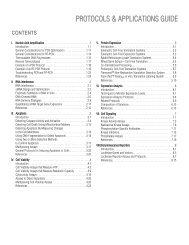2012 Promega catalogue
2012 Promega catalogue
2012 Promega catalogue
You also want an ePaper? Increase the reach of your titles
YUMPU automatically turns print PDFs into web optimized ePapers that Google loves.
Life<br />
Science<br />
Catalog<br />
<strong>2012</strong><br />
Worldwide Contact List<br />
Section<br />
Contents<br />
Table of<br />
Contents<br />
Cell Signaling<br />
42<br />
CytoTox-Fluor Cytotoxicity Assay<br />
Product Size Cat.# Price ($)<br />
CytoTox-Fluor Cytotoxicity Assay 10 ml G9260 201.00<br />
For Laboratory Use.<br />
5 × 10 ml G9261 745.00<br />
2 × 50 ml G9262 1115.00<br />
Description: The CytoTox-Fluor Cytotoxicity Assay measures the relative<br />
number of dead cells in cell populations. The assay uses a fluorogenic peptide<br />
substrate (bis-alanyl-alanyl-phenylanlanyl-rhodamine 110; bis-AAF-R110)<br />
to measure “dead-cell protease activity,” which has been released from cells<br />
that have lost membrane integrity. The bis-AAF-R110 substrate cannot cross<br />
the intact membrane of live cells and therefore gives no signal from live cells.<br />
The assay is designed to accommodate downstream multiplexing with several<br />
<strong>Promega</strong> luminescent assays or spectrally distinct fluorescent assay methods,<br />
such as assays to measure caspase activation, reporter gene expression or<br />
orthogonal measures of viability.<br />
Features:<br />
• Measure the Relative Number of Dead Cells in Culture: Homogeneous,<br />
“add-mix-measure” protocol eliminates parallel plate processing<br />
and reduces cell culture costs.<br />
• Get More Data from Every Well: Multiplex the CytoTox-Fluor Assay<br />
with several <strong>Promega</strong> luminescent cell-based assays.<br />
• Normalize Downstream Multiplex Data for Cytotoxicity: Data<br />
normalization for dead-cell number makes results more comparable wellto-well,<br />
plate-to-plate, day-to-day.<br />
• Reduce Assay Variability: The homogeneous “add-mix-measure”<br />
protocol avoids the cumulative error associated with multistep protocols.<br />
Storage Conditions: Store at –20°C.<br />
Protocol Part#<br />
CytoTox-Fluor Cytotoxicity Assay TB350<br />
CytoTox-ONE Homogeneous Membrane<br />
Integrity Assay<br />
Product Size Cat.# Price ($)<br />
CytoTox-ONE Homogeneous<br />
200–800 assays G7890 196.00<br />
Membrane Integrity Assay<br />
CytoTox-ONE Homogeneous<br />
1,000–4,000 assays G7891 741.00<br />
Membrane Integrity Assay, HTP 1,000–4,000 assays G7892 741.00<br />
For Research Use Only. Not for Use in Diagnostic Procedures.<br />
Description: The CytoTox-ONE Homogeneous Membrane Integrity Assay<br />
is a fluorometric method for estimating the number of nonviable cells present<br />
in multiwell plates. The CytoTox-ONE Assay rapidly measures the release<br />
of lactate dehydrogenase (LDH) from cells with a damaged membrane. LDH<br />
released into the culture medium is measured with a 10-minute coupled<br />
enzymatic assay that results in the conversion of resazurin into a fluorescent<br />
resorufin product. The amount of fluorescence produced is proportional to<br />
the number of lysed cells. The CytoTox-ONE Reagent does not damage<br />
normal healthy cells; therefore the reactions to measure released LDH can be<br />
performed directly in assay wells containing a mixed population of viable and<br />
damaged cells.<br />
The CytoTox-ONE Homogeneous Membrane Integrity Assay, HTP offers<br />
convenient, alternative packaging for processing multiple plates. Each bottle<br />
of reagent supplied with the system is sufficient to perform 500 assays in a<br />
96-well format or 2,000 assays in a 384-well format when the recommended<br />
volumes are used.<br />
Features:<br />
• Save Time: Complete the assay in the cell culture plate, without a sample<br />
transfer step; read data in 10 minutes, compared to 30 minutes or more<br />
with classic LDH assays.<br />
• Multiplex This Assay: Perform multiple assays on one sample with other<br />
homogeneous cell-based assays from <strong>Promega</strong>.<br />
• Adapt Protocol to Your Needs: Using the provided stop solution, assays<br />
can be read over several hours while still maintaining good signal.<br />
• Automate This Assay: Validated automated methods available at:<br />
www.promega.com/automethods/<br />
• Choose Your Configuration: Learn more about our custom options for<br />
this product at: www.promega.com/myway/<br />
Storage Conditions: Store at –20°C protected from light.<br />
Protocol Part#<br />
CytoTox-ONE Homogeneous Membrane Integrity Assay Technical<br />
Bulletin<br />
TB306<br />
Fluorescence (LDH)<br />
3,000<br />
2,800<br />
2,600<br />
2,400<br />
2,200<br />
2,000 0 200 400 600 800 1,000 0<br />
CytoTox-ONE Assay<br />
Staurosporine (nM)<br />
Caspase-Glo ® 3/7 Assay<br />
Multiplexing the CytoTox-ONE Assay and the Caspase-Glo ® 3/7<br />
Assay. With most in vitro apoptosis assays, LDH release occurs<br />
relatively late during the process. The duration of drug exposure here<br />
was carefully chosen to demonstrate the early stages of cell lysis, while still<br />
retaining caspase activity.<br />
For complete and up-to-date product information visit: www.promega.com/catalog<br />
70<br />
60<br />
50<br />
40<br />
30<br />
20<br />
10<br />
Luminescence (caspase)<br />
4745MA
















